Winter Escapades: Embracing a Versatile Winter Wonderland
By Olivia Maclean
As winter blankets the landscape with its pristine coat of snow, adventurers of all kinds eagerly await the opportunity to delve into the snowy wonderlands. Weather-conscious locals make the most of new snow and blue skies as the parking lots along Wolf Creek and Molas Passes fill with visitors from afar who have been tracking the most recent storm; each snowfall a fresh invitation to explore.
For skiers, the season heralds endless opportunities to carve powder-laden slopes and explore the serene beauty of the snow-covered San Juan and Rio Grande National Forests. From the adrenaline rush of downhill descents on Lobo Overlook to the tranquil solitude of Nordic trails at Big Meadows or Fall Creek, each outing offers the pure essence of winter.
Snowshoers, too, find their winter haven amidst the serene landscapes of the National Forests. Their snowshoes allow them to tread softly over the deep snow while witnessing the undisturbed wildlife and the intricate frost patterns across the landscape.
Snowmobilers from across the country keep a vigilant eye for snowfall to have a chance at cruising across vast expanses of Wolf Creek Pass with their machines; winter provides a playground waiting to be explored. While skiers, snowshoers, and snowmobilers share a passion for exploration, conflicts sometimes arise. Skiers and snowshoers, accustomed to the tranquility of gliding through the snow under their own power, may find the roar and tracks of snowmobiles disruptive to the experience. Likewise, snowmobilers, who relish the freedom to roam, are irritated at the thought of their terrain being diminished.
Yet, skiers, snowshoers, and snowmobilers share a common bond—a deep appreciation for the beauty and grandeur of the champagne powder of Colorado. The majority of motorized and non-motorized recreationists understand the importance of responsible recreation, respecting the ecosystems that they traverse and minimizing their impact on the environment.
The San Juan Mountains Association (SJMA), in partnership and with support from the San Juan and Rio Grande National Forests, has employed two snow ambassadors this winter. Colin Courtney has been stationed at the Andrews Lake parking lot, where SJMA has been stationed for the 3rd consecutive winter season, and Olivia Maclean has served as our inaugural Snow Ambassador at Wolf Creek Pass.
Throughout the winter, SJMA offers educational programs centered on understanding our wintry world better. SJMA Snow Ambassadors have interacted with more than 2,300 winter recreationists – both motorized and non-motorized – to ensure that they understand daily avalanche and weather conditions and the importance of recreating responsibly. This partnership is essential in nurturing mutual respect among all individuals dedicated to maintaining unrestricted access to National Forests no matter how they enjoy the region’s vast public lands.
Many of us share a common love for the winter landscape. By recognizing and respecting each other's preferences and adhering to established trail guidelines (set in place by the respective Forest Service), skiers, snowshoers, and snowmobilers can coexist harmoniously, ensuring that everyone can enjoy the splendor of this region’s snowy wonderland in their own ways.
Olivia Maclean, SJMA’s Wolf Creek Snow Ambassador, cherishes both backcountry skiing and snowmobiling.
- Published in Stewardship, Winter
Join the Effort to Make a Positive Impact on Public Lands
by David Taft
Carl Sagan once mused, “who are we, if not measured by our impact on others”, and as members of a thriving community and a dynamic ecosystem, we all have impacts on our surroundings and society. In the context of public lands, which are so essential to our economy and sense of place, these impacts can vary wildly from restorative to devastating. Ultimately, we all must strive to understand the negative impacts so that we can design effective solutions to maximize positive impacts.
Recent years have taught us profound lessons about what can happen when the balance starts to tip towards negative impacts. We saw this through the unexpected public lands boom of 2020, the desperate need for educational outreach throughout heavy-use areas, the Ice Fire, and the ways in which all of these impact the watershed, forests, trails and surrounding communities. Fortunately, the lessons learned from recent years have guided new and innovative approaches towards land management, invigorated partnerships, and spurred community members towards a level of engagement commensurate with challenges at hand.
This year at the San Juan Mountains Association (SJMA), we will be working closely with land management agencies and community partners to amplify the positive impact we have on public lands. As with the past two years, our Wilderness Stewardship Crew will be working throughout the Weminuche, Hermosa Creek, and Lizard Head Wildernesses. They’ll be educating visitors about best practices, clearing trails such as the Needle Creek trail, and performing monitoring to ensure future management is well-informed. You will also see our Forest Ambassadors throughout the San Juan, and, new for this year, the Uncompahgre National Forests. They’ll be promoting Leave No Trace principles, maintaining trails, and collecting user data to help us understand on-the-ground conditions. Our Alpine Loop Ambassador will also be patrolling the high passes, improving outreach capacity on these spectacular roads and offering help to the quarter-million visitors who tour this world-renowned amenity. Last year, SJMA ambassadors racked up tens of thousands of educational contacts, and they’ll be working hard this year to top last year’s accomplishments.
Our staff are only one piece of the puzzle towards maximizing positive impact in the San Juans. We’ve been a volunteer-driven organization since our inception, and this year will be no different. We have a raft of new (or returning) opportunities to give back, including getting out as a volunteer trail ambassador, spending a few days doing public outreach, learning how to clear downed trees with a crosscut saw. The tens of thousands of volunteer hours contributed each year to our public lands make all the difference, and we are here to ensure that community members have everything they need to give back in whatever way they can.
As we transition into our busiest season of the year, we encourage everyone to sign up for a volunteer day, give one of our seasonal staff words of support, and most importantly enjoy their time in the San Juans in a respectful and low-impact way. With another busy fire season to our south already, it will likely be a popular year to the San Juans, and we all need to do our part to protect the places we love. Visit sjma.org for more information on how to give back.
- Published in Stewardship
San Juan Mountains a laboratory for the study of avalanches
By Alex Miller
The San Juan Mountains Association works in partnership with our federal public lands partners to ensure that visitors to our mountains can continue to enjoy the grandiose viewsheds, beautiful hiking trails, world class off-roading, designated Wilderness Areas, and incredible winter recreation opportunities that make this area great.
Along with these claims to fame, the San Juans are also known for the huge number of avalanches they produce in the winter. Avalanches are cascading piles of snow, ice, and debris that occur on slopes steeper than thirty degrees. They require snow, which we often have here, and mountainous terrain, which we always have. Though only a winter hazard, avalanches are responsible for killing numerous backcountry travelers each year. Luckily, some wonderful resources can help visitors to southwest Colorado stay safe this winter. The Colorado Avalanche Information Center (CAIC) and the San Juan Mountains Association’s public lands stewardship programming both strive to inform winter recreationists on how to stay safe and recreate responsibly this winter.
Before the Rocky Mountains were so densely settled, mining town residents observed avalanches and developed local knowledge to avoid perishing in them. Greenhorns were filled in on how to survive their commutes to the mine, and when disaster struck, whole communities participated in rescue efforts (Di Stefano 2015). With the advent of winter recreation after World War II, local avalanche knowledge rapidly developed into a field of research with help from the US Forest Service and ski areas they managed (National Forest Foundation 2015). As the field grew, so too did the research locations, and what better place to study avalanches than the San Juan Mountains.
Several prominent avalanche researchers worked in the San Juans from the 1970s onward through the Institute of Arctic and Alpine Research’s (INSTAAR) San Juan Avalanche Project (INSTAAR History). The project’s goal was to study what caused so many avalanches here and how to mitigate the hazard they created along HWY 550. Researchers brought their avalanche experience to Silverton and, in the tradition of their mining predecessors, developed a strong, localized understanding of avalanches. This time, their local knowledge contributed to a broader community of avalanche researchers across the world and was informed by decades of scientific discussion. Between local observations and universal knowledge, INSTAAR researchers could more accurately predict when to close HWY 550 and similar mountain highways. Thus, the San Juans became not only a hub for avalanches, but a hub for their study.
After an avalanche buried and killed HWY 550 snow plow driver Eddie Imel in 1992, CDOT began sponsoring the CAIC, an organization responsible for studying and forecasting avalanche conditions throughout the state (Knox Williams 2020). The CAIC draws from the pool of knowledge established in mountains around the world, pairs it with local observations from individual mountain ranges like the San Juans, and spreads information in digestible ways to residents like you and me. For winter recreationists, checking the CAIC avalanche forecast is the first step to a fun day in the mountains. By providing this important information, the CAIC and avalanche researchers around the West are playing a vital role in helping visitors to the San Juans have safe, enjoyable trips into the mountains.
Through our winter programming and snow ambassador program, the San Juan Mountains Association is also doing its part in showing residents and visitors how to recreate responsibly in the snow. This winter, join us on one of our Full Moon Howler trips (hosted by the Durango Nordic Center), our bi-weekly Aprés Ski Science & Socials on Saturday afternoons outside the Outdoor Research tiny house north of Andrews Lake, or say “Hi” to our snow ambassador John next time you’re out for a ski tour near Molas Pass.
Alex Miller is the Montrose Public Lands Ambassador for the San Juan Mountains Association.
- Published in History, Stewardship, Winter
Celebrate Christmas and support SJMA by buying a tree
By Shannon Daily
Here at San Juan Mountains Association, we have experienced a bustling, exciting and fulfilling summer and fall. Whether it be our educators running science-based summer camps for youth, our Forest Ambassadors hitting the trails to spread the message of Leave No Trace, or our Visitor Information Specialists educating visitors about our forests, all of us at SJMA have experienced great satisfaction in working towards our mission to inspire and empower connection to and responsible use of the spectacular public lands of Southwest Colorado.
As our busy field season winds down and the golden leaves have turned to brown, we find ourselves ramping up for our biggest fundraiser of the year, Christmas Trees for Conservation. We would like to invite you to join us on the Tree Lot this year. You can volunteer by working a shift at the Tree Lot or stop by to purchase your Christmas tree from us and browse our Pop-Up Shop for some local stocking stuffers. Here are a few reasons why we operate the Tree Lot.
First, the Christmas trees! SJMA sells both freshly cut local white fir and farmed balsam fir trees from Wisconsin. The local white firs grow right here in the San Juan National Forest, which means an almost nonexistent transportation carbon footprint. There are no pesticides, fertilizers, or irrigation used so the white firs are not as full as trees from a tree-farm, and have smaller trunks. A large group of SJMA volunteers goes into the forest and cuts these trees from a designated area. Working in conjunction with our partner, the San Juan National Forest, thinning white fir along the road helps prevent catastrophic fires and protects the overstory trees from a crown fire. White firs represent the locally-grown option on our lot and bring a little bit of the San Juan National Forest into your home. We also sell farmed balsam fir trees which are grown in Wisconsin. The ideal growing conditions and fertilization allow the balsam trees to reach a perfect shape and size.
A second reason that we operate the Tree Lot is the camaraderie felt from working toward a common goal. Volunteering for a 3 hour shift at the sale is a wonderful way to spend time during the holiday season. Likely, you’ll see people you know from around the area and help them purchase the perfect tree.
Lastly, the proceeds from the Tree Lot go to supporting SJMA’s mission, and serves as our largest fundraiser of the year. We are deeply grateful for all the support from the community. The Tree Lot opens on Friday November 26th at noon and is open every day until the trees sell out. Last year, we sold out in under three weeks, so don’t delay! The hours are Sundays – Fridays from 12:00pm – 6:00pm; Saturdays from 9:00am – 6:00pm. The lot is located at the corner of Camino del Rio and College Avenue in Durango.
Whether it be volunteering or shopping, we hope to see you at the Tree Lot! Learn more and sign up to volunteer at www.sjma.org.
Another way to support SJMA? Check out Sticker Mule for the fastest and easiest way to buy custom stickers and other printed products! Thank you Sticker Mule for your support!
- Published in Stewardship, volunteers
Supporting Wilderness and the Immense Value It Provides
By David Taft
In his wildly popular 1968 book Desert Solitaire, Ed Abbey claimed that “we need wilderness whether or not we ever set foot in it. We need a refuge even though we may never need to go there.” Whether one seeks to explore the deepest depths of our greatest wildernesses, shoots a photo of the solemn peaks from the highway shoulder, or relies upon the water and clean air provided by their lush forests and lofty mountainous heights, we all benefit from the existence of healthy open spaces. More so than ever, in the midst of a devastating pandemic and in the aftermath of a catastrophic wildfire season, we can see how our wild places provide enormous value to our economies as well as the physical and emotional wellbeing of our society.
We have a particularly clear view of the value received from our mountain forests in regard to water storage and purification as we watch the recovery in the Cameron Peak Fire zone. This fall, the downstream towns which rely on the Poudre River for water are spending $300,000 each day dropping mulch from helicopters in an attempt to prevent debris slides, allow for greater water uptake into the soil, and to keep sediment from polluting the water system. According to engineers this is a relatively small price to pay compared to the damage caused by debris flows into rivers and reservoirs, and the associated purification costs incurred to amend that situation. Considering that not only our small community, but eventually 20 million people in the Colorado River Basin rely on water from our local wildernesses, it’s easy to imagine just how integral this resource is to our society.
In addition to the profound importance of healthy forests to our water system, there is a well documented and growing body of research indicating that access to open space is among the most significant factors in determining mental health outcomes. In Southwest Colorado we are fortunate enough to have millions of acres of open space within a short drive, walk, or bike ride, and it goes without saying that this is one of the greatest reasons for continued growth in our communities. A Dutch study of over a million residents found that access to open space has the second highest correlation with positive mental health outcomes of all the factors studied. This is exceptionally important during a pandemic in which the CDC finds increases of anxiety and depression incidences 3-4 times higher than in previous years.
Given these exceptional benefits of healthy open space to our society and economy, we must continue finding effective and creative solutions to protect them. This summer, crews from the San Juan Mountains Association educated over 15,000 forest visitors about Leave No Trace practices and wildfire safety, covered hundreds of miles monitoring trail and forest conditions, hauled out almost 2,000 pounds of trash, naturalized 300 illegal fire rings, and cleared over 600 downed trees from San Juan Mountain trails. Through these efforts, our staff have not only played a valuable resource in educating forest visitors about how to protect this immense resource, but also ensured that visitors and locals alike are able to benefit from their time in the mountains. Each year during the month of October, we like to take a moment to thank these crews for the work they’ve done, and encourage everyone to do so by ensuring the financial viability of this program. Visit our website at sjma.org to become a member and support these efforts, and thank our field staff next time you see them on trail for all their hard work!
- Published in Stewardship
Mindful Moments
By SJMA Forest Ambassador, Jojo Matson
Alpine tundra ecosystem services
May you be mindful that the alpine tundra is an incredibly special place for our entire ecosystem near and far. Everything underneath your feet is alive. The tundra ecosystem acts as a giant and delicate sponge created by a network of roots reaching up to two feet deep. This sponge holds our snowpack through the winter and reduces avalanche potential. It holds our soils together allowing moisture from snowmelt and spring monsoon storms to absorb into the ground instead of running off or triggering a mudslide. What most of you might notice are the abundant flower varieties that feed large populations of pollinators and herbaceous animals.
Every impact to that delicate sponge compresses the network of roots. The more compressed it becomes, the less effective it is at holding the ecosystem together. Look along the trail on the edges of the footpath and see how far it has compressed from the surrounding soil from feet and tires. Notice areas of increased water flow in the trail and the rapid erosion that takes place within a short amount of time. Once the erosion begins, it is very hard to stop on its own and is amplified and widened when we try to avoid the impacted areas. At some point, the impact might be irreversible, and the trail will become a large gully for water runoff.
May you be mindful where your feet, your furry friend’s feet, or your tires go today.
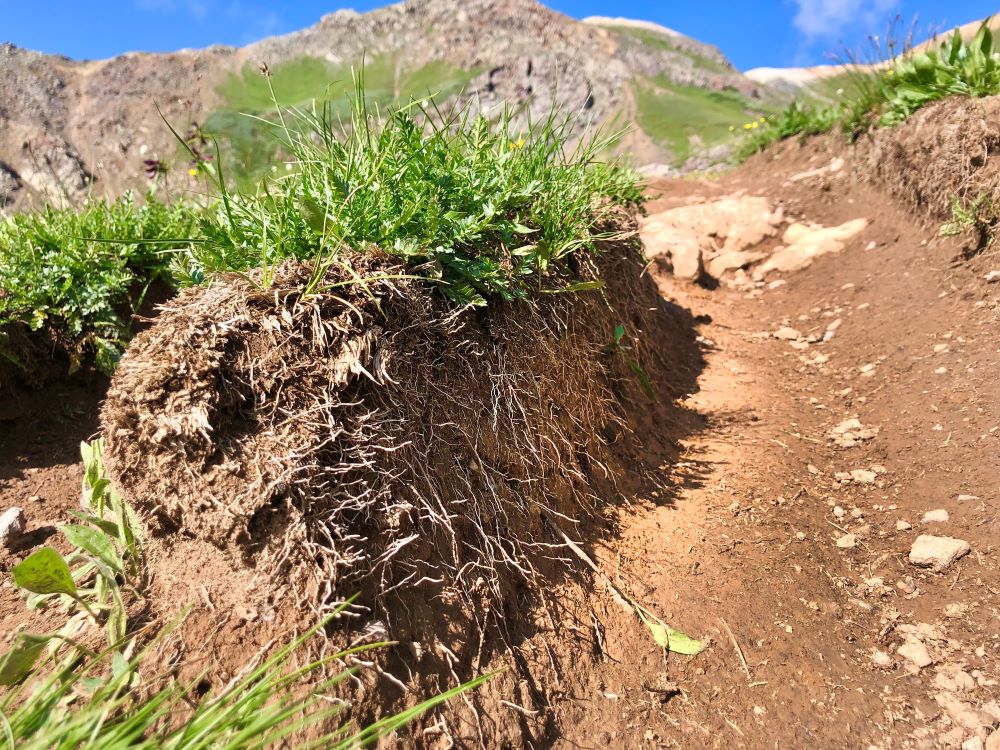
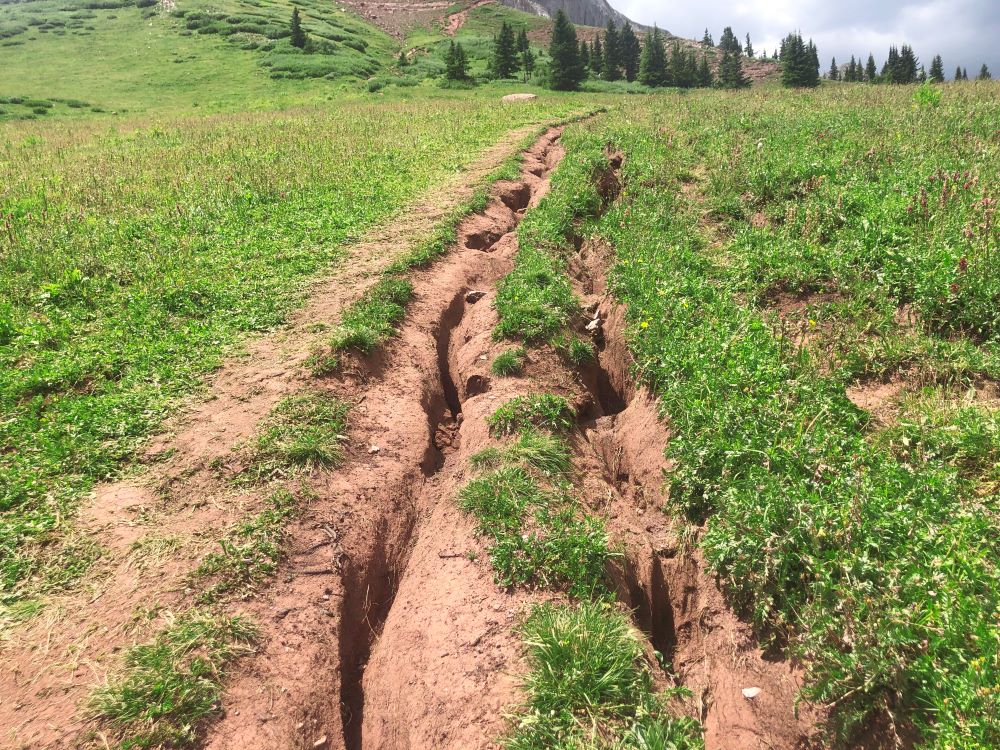
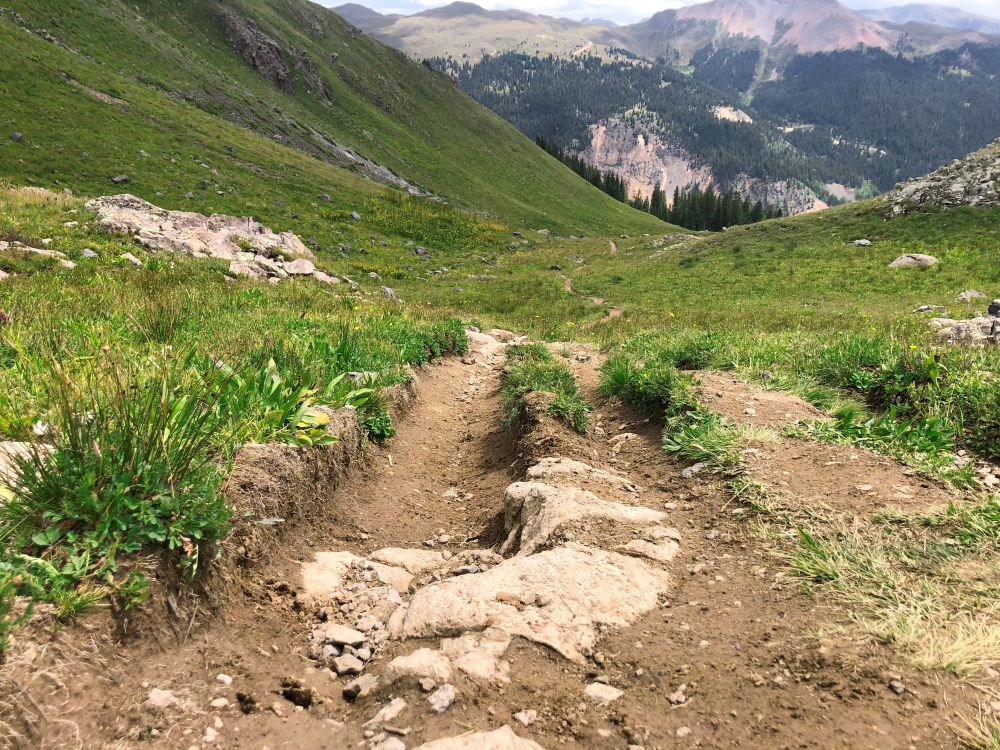
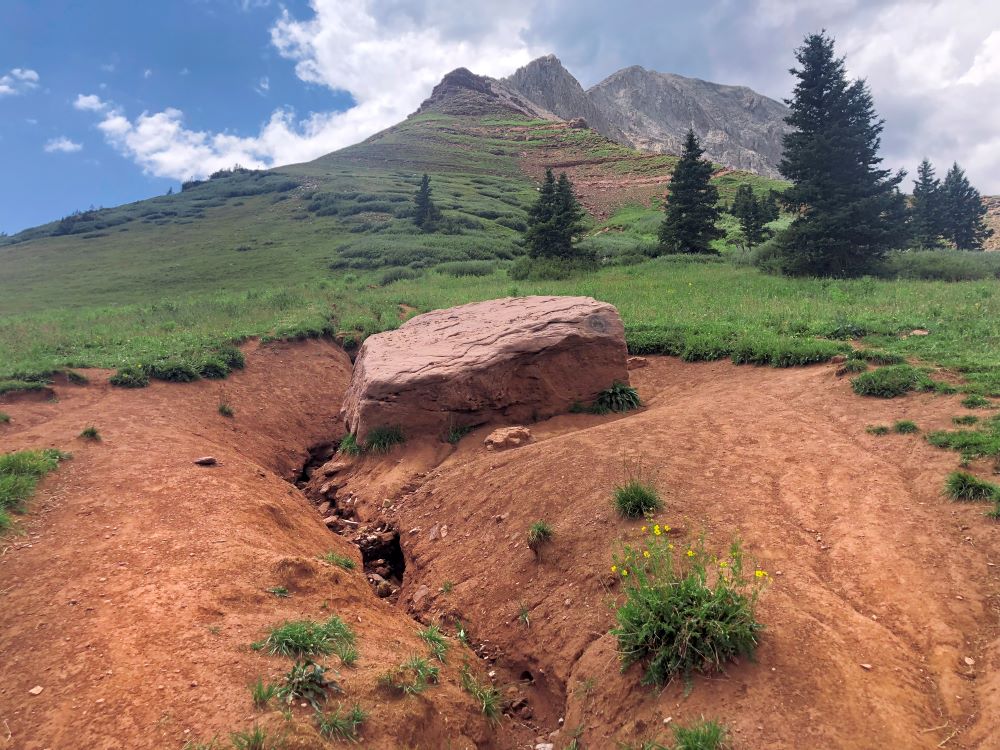
Alpine tundra, visitors in an ecosystem homestead
May you be mindful that the alpine tundra is a unique and diverse ecosystem that supports lifeforms near and far in an incredible balanced network of traveling and permanent dwellers. Some of these neighborhoods are confined to the tops of our mountains and are bound by the environmental boundaries of elevation, temperature, and water. This neighborhood is a collection of specialized flowers and plants and the specialized creatures that eat them. One you may be familiar with is the pika, a small and adorable furry creature that greets you as you enter the high country with loud chirps. The pika is very special because it can only survive in our high cool mountaintops. They cannot withstand temperature above 77 degrees F. They also do not sleep the winter away but survive awake underneath the snowpack. It spends all summer collecting, drying, and storing plants in stashed piles underneath rocks all over the tundra. Their knowledge of each plant’s necessary drying and storage time is miraculous. All the while, they spread seeds and propagate the environment they need to survive in the next year. They are as brilliant as they are adorable.
When you visit the tundra, you will notice there are not many places to hide. A few boulders, scree rock slopes, and valleys of flowers. The pikas have storage stacks that are in safe regions for them to use later. When our feet or out furry friend’s feet go near or invade the storage areas, it can lead to the pika getting hurt or stopping collection of food at that location.
May you be mindful while you visit the tundra where your feet and your furry friend’s feet go. We are there for a short time, and the pika calls it home.
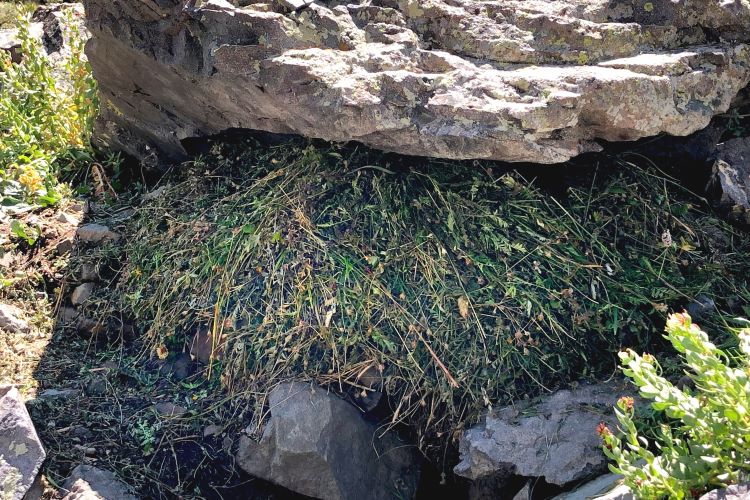
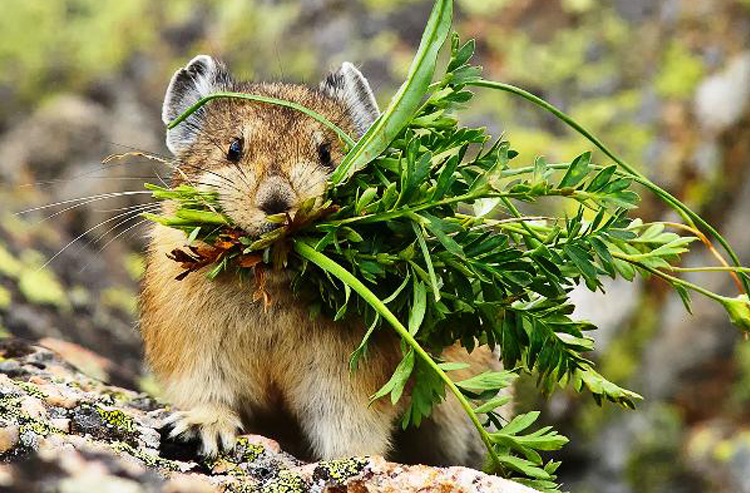
The heartstrings for the trees
May you be mindful that the San Juan Forest is a uniquely biodiverse ecosystem ranging from a dry desert range to the high alpine mountaintops. Everything under your feet is alive including the streams, soils, and the network of mycorrhizal and root systems holding the soils together. Every change in elevation and moisture creates a specialized ecosystem composition that is as unique as a fingerprint to anywhere else.
Notice the changes to the areas that have seen impacts from repeated use to the areas that have been left untouched. Notice what life does or does not survive underfoot. See that the giant roots that grow across the trail are the heart strings for the beautiful trees that stretch above you. Their roots are not deep, they spread wide as they grip to the side of a mountain. These trees are already taxed from impacts of smoky air, insect infestations, and rising temperatures all while they do the important job of stabilizing our mountains and cleaning our air.
May you be mindful of those heart strings while you are out underneath their canopy.
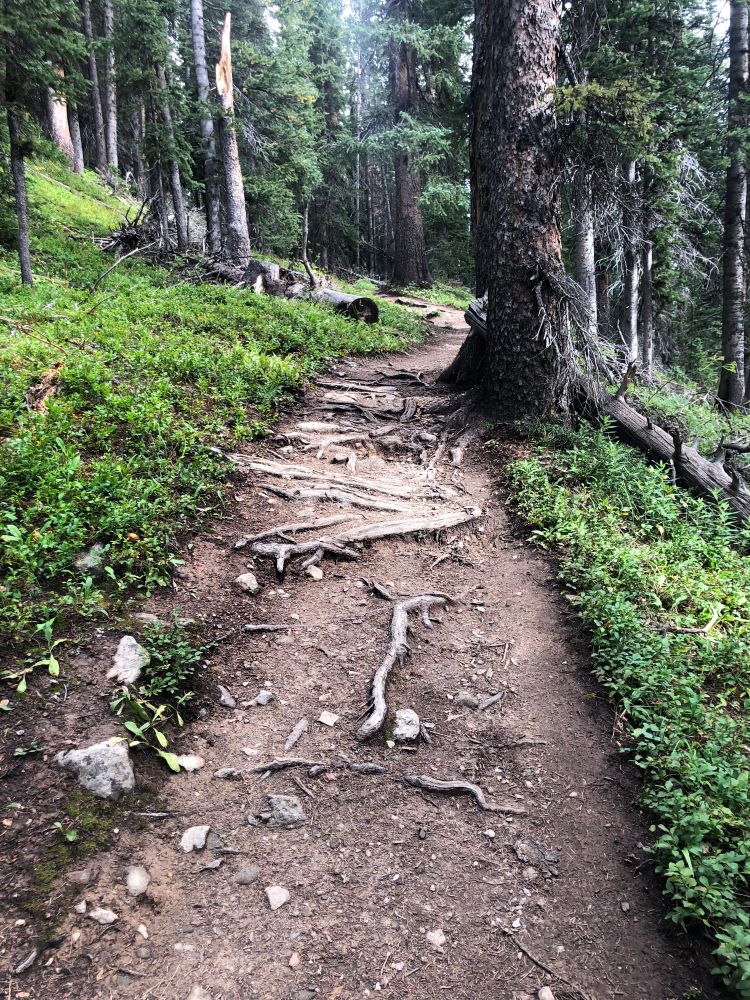
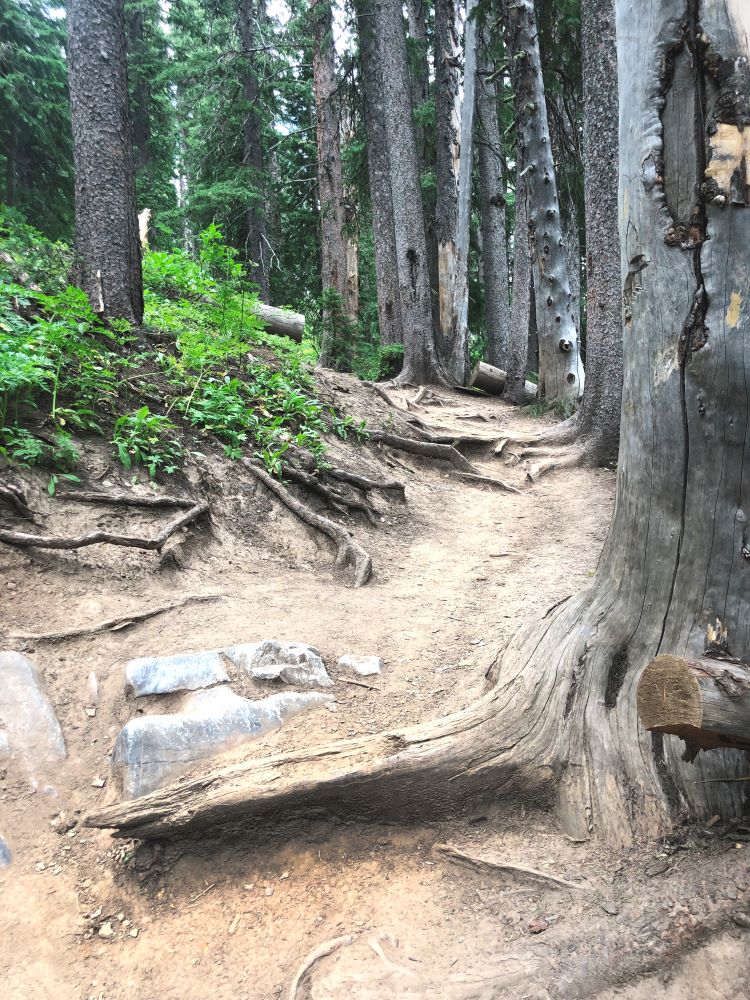
- Published in Stewardship
Wilderness Crew protects a majestic, powerful landscape
By Ana Siegel, SJMA Wilderness Crew Member
For the last two months, my office has been the burn zones, alpine vistas, cow-filled meadows, and log-strewn trails of the Weminuche Wilderness. As a member of the San Juan Mountains Association’s Wilderness Crew, I have the privilege of spending my work week immersing myself in, and helping to protect, this beautiful and unique landscape.
To understand the work we do, it is necessary to grasp the goals of the 1964 Wilderness Act: “Wilderness should be administered for the use and enjoyment of the American people in such manner as will leave them unimpaired for future use and enjoyment as wilderness, and so as to provide for the protection of these areas, the preservation of their wilderness character, and for the gathering and dissemination of information regarding their use and enjoyment as wilderness.”
Our aim as the Wilderness Crew is to facilitate the balance between easing visitor access to and enjoyment of this land, while protecting both the landscape and its character. Depending on the week, our focus is on either trail work or campsite monitoring. Most recently, we cleared a trail in the Rio Grande National Forest–using only non-mechanized tools, like crosscut and hand saws–allowing for easier foot and stock access to an alpine lake. Other weeks, we hike remote trails, collecting data on already-existing or new campsites, dispersing illegal campsites, and carrying out as much trash as we can fit in our packs. On the first hitch of our season, we carried out nearly 85lb of trash and abandoned supplies.
Most significant to me, is the way that these weeks in the field have deepened my own understanding of wilderness character. This week, two of our work days were cut short due to dangerous weather conditions; lightning strikes with almost immediate thunder claps prompted us to decide to return to lower ground and wait out the storm in our camp. Waiting for the storm to pass in my tent, I felt humbled by the power of this place and the lack of power that we have as visitors in wilderness. I think that reaches the crux of wilderness character: that feeling of ceding control, entering an environment where you are humbled by both the power and the beauty of the natural world, “untrammeled by man,” as the Act puts it.
As our crew experiences on a daily basis, this wilderness character does not always make our lives easy: it’s that feeling of willingly putting yourself in the position of being cold, wet, sore, and daydreaming about that piece of pizza you’re going to eat the very second you get back to town, while simultaneously being in awe of the place you’re in. Wilderness character is the now-infrequent experience of being at the whim of the natural world. In a society where we have predominantly controlled our environments for our own use, safety, and enjoyment, it is a welcome-challenge–refreshing, even–to relinquish that control.
The efforts of our Wilderness Crew to both improve access to and protect the Weminuche Wilderness ultimately contribute to the protection of this character. It’s a fine line to walk: visitors must travel with care in order to protect the landscape. But, I hope that the work we are doing allows future visitors the opportunity to experience the joy, challenge, and resulting empowerment that I have experienced during my time working here in the Weminuche.
- Published in Stewardship
Appreciating Together
By Julia Ledford, SJMA Forest Ambassador
I know what it’s like when the crowds find your secret spot. I’ve known waterfalls and powder stashes and pristine lakes that I could once visit without seeing another soul. But now, the secret is out. I’ve also been the one to stumble upon someone else’s special place and disrupt their solitude. Most likely, so have you.
I’ve known people that complain more about other people on the trail than they appreciate what’s around them, and I’d be lying if I said I’ve never fallen into the same trap. Let’s be honest, passing hordes of other hikers and hearing dogs barking or seeing toilet paper in the woods isn’t what we imagine for an ideal day in the mountains.
Being a Forest Ambassador has changed my perspective. I spend my days hiking in the places that many locals say have been “ruined” by mountain bikers or the sheer number of visitors. My job is to deliberately engage with all of these people with the goal of reducing our collective impact on the landscape. I have learned what an honor it is to share these incredible places with others, and to appreciate watching so many people smile at the same things that make me smile. Instead of rolling my eyes at the group of nine hikers approaching me on the trail, I welcome them to this breathtaking meadow of wildflowers and educate them on how to keep it that way. Together, we share the joy of being surrounded by such magnificence, and almost always, we learn something from each other. After all, understanding these places is the first step to protecting them.
The truth is, your secret spot won’t be yours forever. People will continue coming to the San Juans, so welcome them, enjoy every second of it, and of course, Leave No Trace.
- Published in Stewardship
Forest Ambassador program showing positive impact in San Juans
By Cassidy Storey
As warm weather and a public eager to get outside returned to the San Juans this summer, Forest Ambassadors hit the trails representing San Juan Mountains Association (SJMA) and the San Juan National Forest (SJNF) in a new stewardship outreach program.
In response to the increased number of visitors to trails, campsites, and popular recreation areas, SJMA launched a crew of skilled and passionate Forest Ambassadors to make public contacts, conduct routine trail maintenance, identify land management issues, implement volunteer stewardship projects, and conduct environmental monitoring. With support from the Rocky Mountain Restoration Initiative and Great Outdoors Colorado, SJMA’s Forest Ambassadors have increased the number of “boots on the ground” during the busiest months of the year helping to protect some of Southwest Colorado’s most treasured public lands.
Forest Ambassadors spend each week maintaining trails, educating the public on “Leave No Trace” principles, and connecting with people in America’s public lands, the only wildlands most of us will ever own. In the last two months, Ambassadors have connected with over 3,000 public land users , rehabilitated more than 100 campfire rings, helped with several outreach events, and created a friendly, knowledgeable presence for visitors that did not exist before.
The new Ambassadors have some interesting stories to tell. As a team, the crew aided Search and Rescue operations, helped injured and lost hikers, identified an undetonated avalanche bomb, removed dozens of pounds of trash, photographed stunning scenes in the high country, and provided hands-on experience that can help inform future outreach efforts.
In early June, while heading back to the trailhead after a productive day on Ophir Pass, one of SMJA’s Forest Ambassadors encountered the Search and Rescue team beginning an evacuation operation. Search and Rescue informed him they had been called by a group of runners with an injured member. Though it was near the end of the day, he offered to help, and they gladly accepted. The runner had tumbled down a steep slope while traveling in the snow and landed off trail with a dislocated shoulder. Emergency medical technicians were able to put the man’s shoulder back in place so he could walk back to the road, but the Forest Ambassador was there to help. This was only the first of several instances so far in which Ambassadors were in the right place at the right time and able to lend their skills and experience to help someone in the San Juans.
Ambassadors have also focused extensively on educating new and returning visitors on “Leave No Trace” principles, a set of ethics promoting conservation in the outdoors. In the SJNF, that means preparing for changing weather, packing out all trash and waste, leaving wildflowers for others to enjoy, keeping sensitive high alpine ecosystems healthy by staying on trails, respecting wildlife by not feeding them and keeping dogs under control, and minimizing campfire impacts which includes following current fire restrictions. As a team, the Forest Ambassadors have shared these ways to “Leave No Trace” with a variety of recreationists from fly fishermen to backpackers.
The SJMA Forest Ambassadors will be hard at work throughout the summer promoting conservation of the San Juan Mountains. They look forward to seeing you out on the trails and are always delighted to tell you more about their work and how you too can act as a responsible steward of your public lands.
Author: Cassidy Storey, Forest Ambassador Field Manager. Cassidy grew up in Colorado and is a recent graduate of Colorado State University passionate about using science to connect people to the outdoors.
- Published in Stewardship
Responding to an Unprecedented Year
By David Taft
From the soaring amphitheater of Ouray, to the turquoise lakes of Silverton, to the red rock canyons of Mesa Verde, it was absolutely unmistakable that last year was unlike any before it. The overwhelmed parking lots, trash strewn trails, and overcapacity camping areas were impossible to miss. Everyone acknowledged that something needed to be done to manage the ballooning growth in visitors on Southwest Colorado’s public lands. If you ask a land manager what the best solution is to improving the situation, invariably they will respond “more boots on the ground”. We need more people to clean up the mess, educate visitors on how to reduce their impact, and ensure that the increased visitation doesn’t harm both the landscape and experience of other visitors. Thanks to our members’ support, an innovative grant from GOCO, collaboration with Mountain Studies Institute and our great agency partners, and a bit of creative thinking, we will be doing exactly that this summer at San Juan Mountains Association.
Starting in May, we will dispatch a crew Forest Ambassadors into the field each day to cover the busiest trails in our region. These Ambassadors will cover a huge swath of public land, ranging from the lofty heights of Lizard Head Pass, to the forested trails of Boggy Draw and Vallecito, to the wildly popular high country peaks around Silverton. The ambassadors will greet hikers at trailheads, alert visitors to fire restrictions, educate them about how to responsibly visit sensitive alpine environments, keep trails in top shape as they go on patrol, and monitor conditions so we can better manage these exceptional places. Furthermore, the ambassadors will team up with volunteers who will amplify the positive impact of this program. This program will provide a perfect opportunity for new volunteers to gain some experience with a land management professional in the field, or for a veteran volunteer to enjoy some quality time sharing their knowledge of a place they love. These volunteers will accompany ambassadors to patrol trails, track visitor numbers at trailheads, and help keep our favorite recreation spots beautiful.
This Forest Ambassador program will dramatically increase the presence of staff on the land in the San Juan National Forest, and establishes a model for private public partnership that agencies, nonprofits, volunteers, and local businesses can all get behind. We encourage you to get out with an ambassador this summer, see what they’re up to, and give them a hand in their daily mission to keep the San Juans beautiful. We all acknowledge the exceptional value of spending time in the outdoors, and want to encourage everyone to enjoy the health and emotional benefits of visiting public land. With this program, we will ensure that we can all enjoy the benefits of time spent outdoors without harming the place, wildlife, or future visitors’ experience.
- Published in Stewardship










